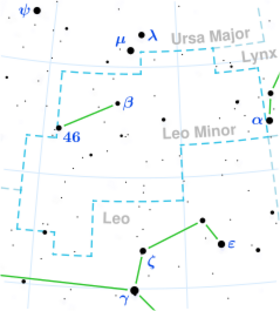Astronomy:10 Leonis Minoris
| Observation data Equinox J2000.0]] (ICRS) | |
|---|---|
| Constellation | Leo Minor |
| Right ascension | 09h 34m 13.38184s[1] |
| Declination | 36° 23′ 51.2090″[1] |
| Apparent magnitude (V) | 4.54[2] |
| Characteristics | |
| Spectral type | G8.5 III[3] |
| U−B color index | +0.61[4] |
| B−V color index | +0.92[4] |
| Variable type | RS CVn[5] |
| Astrometry | |
| Radial velocity (Rv) | −11.94[6] km/s |
| Proper motion (μ) | RA: +6.989[1] mas/yr Dec.: −22.729[1] mas/yr |
| Parallax (π) | 17.0738 ± 0.1341[1] mas |
| Distance | 191 ± 2 ly (58.6 ± 0.5 pc) |
| Absolute magnitude (MV) | 0.83[7] |
| Details | |
| Mass | 2.54[8] M☉ |
| Radius | 9.20[8] R☉ |
| Luminosity | 51.4[8] L☉ |
| Surface gravity (log g) | 2.93[9] cgs |
| Temperature | 5,099[8] K |
| Metallicity [Fe/H] | −0.04[9] dex |
| Rotational velocity (v sin i) | 4.7[10] km/s |
| Other designations | |
| Database references | |
| SIMBAD | data |
10 Leonis Minoris is a single[12] variable star in the northern constellation Leo Minor, located approximately 191 light years away based on parallax. It has the variable star designation SU Leonis Minoris; 10 Leonis Minoris is the Flamsteed designation. This body is visible to the naked eye as a faint, orange-hued star with a baseline apparent visual magnitude of 4.54.[2] It is moving closer to the Earth with a heliocentric radial velocity of −12 km/s.[6]

This is an evolved giant star with a stellar classification of G8.5 III.[3] It is reported as a RS CVn variable with magnitude varying by 0.02 mag.[5] and showing a high level of chromospheric activity.[14] The star has 2.54 times the mass of the Sun and has expanded to 9.20 times the Sun's radius. It is radiating 51.4 times the luminosity of the Sun from its enlarged photosphere at an effective temperature of 5,099 K.[8]
References
- ↑ 1.0 1.1 1.2 1.3 1.4 Vallenari, A. et al. (2022). "Gaia Data Release 3. Summary of the content and survey properties". Astronomy & Astrophysics. doi:10.1051/0004-6361/202243940 Gaia DR3 record for this source at VizieR.
- ↑ 2.0 2.1 Anderson, E.; Francis, Ch. (2012). "XHIP: An extended hipparcos compilation". Astronomy Letters 38 (5): 331. doi:10.1134/S1063773712050015. Bibcode: 2012AstL...38..331A. Vizier catalog entry
- ↑ 3.0 3.1 Hoffleit, D.; Warren, W. H. (1995). "VizieR Online Data Catalog: Bright Star Catalogue, 5th Revised Ed. (Hoffleit+, 1991)". VizieR On-line Data Catalog: V/50. Originally Published in: 1964BS....C......0H 5050. Bibcode: 1995yCat.5050....0H.
- ↑ 4.0 4.1 Mermilliod, J. C. (2006). "VizieR Online Data Catalog: Homogeneous Means in the UBV System (Mermilliod 1991)". VizieR On-line Data Catalog: II/168. Originally Published in: Institut d'Astronomie 2168. Bibcode: 2006yCat.2168....0M.Vizier catalog entry
- ↑ 5.0 5.1 Watson, C. L. (2006). "The International Variable Star Index (VSX)". The Society for Astronomical Sciences 25th Annual Symposium on Telescope Science. Held May 23–25 25: 47. Bibcode: 2006SASS...25...47W.
- ↑ 6.0 6.1 Massarotti, Alessandro; Latham, David W.; Stefanik, Robert P.; Fogel, Jeffrey (2008). "Rotational and Radial Velocities for a Sample of 761 Hipparcos Giants and the Role of Binarity". The Astronomical Journal 135 (1): 209–231. doi:10.1088/0004-6256/135/1/209. Bibcode: 2008AJ....135..209M.
- ↑ Da Silva, Ronaldo; Milone, André de C.; Rocha-Pinto, Helio J. (2015). "Homogeneous abundance analysis of FGK dwarf, subgiant, and giant stars with and without giant planets". Astronomy & Astrophysics 580: A24. doi:10.1051/0004-6361/201525770. Bibcode: 2015A&A...580A..24D. Vizier catalog entry
- ↑ 8.0 8.1 8.2 8.3 8.4 Reffert, Sabine; Bergmann, Christoph; Quirrenbach, Andreas; Trifonov, Trifon; Künstler, Andreas (2015). "Precise radial velocities of giant stars". Astronomy & Astrophysics 574: A116. doi:10.1051/0004-6361/201322360. Bibcode: 2015A&A...574A.116R. Vizier catalog entry
- ↑ 9.0 9.1 Wu, Yue; Singh, H. P.; Prugniel, P.; Gupta, R.; Koleva, M. (2010). "Coudé-feed stellar spectral library – atmospheric parameters". Astronomy & Astrophysics 525: A71. doi:10.1051/0004-6361/201015014. Bibcode: 2011A&A...525A..71W.
- ↑ De Medeiros, J. R.; Alves, S.; Udry, S.; Andersen, J.; Nordström, B.; Mayor, M. (2014). "A catalog of rotational and radial velocities for evolved stars". Astronomy & Astrophysics 561: A126. doi:10.1051/0004-6361/201220762. Bibcode: 2014A&A...561A.126D. Vizier catalog entry
- ↑ "10 LMi". SIMBAD. Centre de données astronomiques de Strasbourg. http://simbad.u-strasbg.fr/simbad/sim-basic?Ident=10+LMi.
- ↑ Eggleton, P. P.; Tokovinin, A. A. (September 2008). "A catalogue of multiplicity among bright stellar systems". Monthly Notices of the Royal Astronomical Society 389 (2): 869–879. doi:10.1111/j.1365-2966.2008.13596.x. Bibcode: 2008MNRAS.389..869E.
- ↑ Skiff, B. A.; Lockwood, G. W. (March 1986). "The photometric variability of solar-type stars. V. The standard stars10 and 11 Leonis Minoris". Publications of the Astronomical Society of the Pacific 98: 338–341. doi:10.1086/131763. Bibcode: 1986PASP...98..338S. https://articles.adsabs.harvard.edu/pdf/1986PASP...98..338S. Retrieved 23 October 2022.
- ↑ Strassmeier, K. G. et al. (January 1994). "Chromospheric activity in G an K giants and their rotation-activity relation.". Astronomy and Astrophysics 281: 855–863. Bibcode: 1994A&A...281..855S.
 |


